The laughingthrushes and babblers are a family of mostly Old World passerine birds. They are rather diverse in size and coloration. These are birds of tropical areas, with the greatest variety in Southeast Asia and the Indian Subcontinent. The entire family was previously included in the Timaliidae.
They are small to medium sized birds. They have strong legs, and many are quite terrestrial. They typically have generalised bills, similar to those of a thrush. Most have predominantly brown plumage, with minimal difference between the sexes, but many more brightly coloured species also exist.
This group is not strongly migratory, and most species have short rounded wings, and a weak flight. They live in lightly wooded or scrubland environments, ranging from swamp to near-desert. They are primarily insectivorous, although many will also take berries, and the larger species will even eat small lizards and other vertebrates.
The genus Turdoides contains about 30 babbler species distributed across Africa and southern Asia. They are typically fairly large, long-tailed birds which forage in noisy groups. The majority of species have drab brown or grey-brown plumage. A few are marsh birds but most occur in open savanna or thornscrub. While Asia is the center of babbler distribution, members of the Leiothrichinae also occur in Africa. These include 14 of the Turdoides babblers.
Africa Wild Bird Book
Family Leiothrichidae (Laughingthrushes) Index
Family Leiothrichidae (Laughingthrushes)
Turdoides melanops Black-faced Babbler 561
Turdoides jardineii Arrow-marked Babbler 560
Turdoides hartlaubii Hartlaub's Babbler 562
Turdoides bicolor Southern Pied Babbler 563
Turdoides gymnogenys Bare-cheeked Babbler 564
Turdoides melanops Black-faced Babbler 561
Turdoides jardineii Arrow-marked Babbler 560
Turdoides hartlaubii Hartlaub's Babbler 562
Turdoides bicolor Southern Pied Babbler 563
Turdoides gymnogenys Bare-cheeked Babbler 564
- Flutterby
- Posts: 44029
- Joined: Sat May 19, 2012 12:28 pm
- Country: South Africa
- Location: Gauteng, South Africa
- Contact:
Arrow-marked Babbler
560. Arrow-marked Babbler Turdoides jardineii (Pylvlekkatlagter)
Order: Passeriformes. Family: Leiothrichidae
Description
Length 23-25 cm, weight 56-86 g. Above brown, with indistinct white spots on the rump and upper tail coverts; below brownish grey, has 'arrow-marked' white streaks on the breast, red-rimmed, yellow eyes. The bill, legs and feet are black. Sexes are alike. They live in groups of up to 12 birds, often all calling simultaneously.
Juveniles have a brown eye and less white streaking than adults and spotted dusky below.
Distribution
North-eastern parts of South Africa, eastern Botswana, north-eastern Namibia, Mozambique and Zimbabwe and north to Kenya and Cabinda (north-western Angola).
Habitat
Semi-arid woodland, especially broad-leaved woodland such as miombo; often close to riparian thickets, and absent from drier central Kalahari.
Diet
Insectivorous; also small reptiles, seeds and small fruit. Recorded feeding on nectar. They forage low down in the undergrowth or on the ground.
Breeding
Arrow-marked Babblers are monogamous and co-operative breeders, building an untidy cup-shaped nest of twigs and dry grass lined with finer material. This is usually placed in thick vegetation 2-4 m above the ground and built by all group members. Egg-laying season is year round, peaking around September-April. The female lays a clutch of two to five, usually 3 blue eggs that hatch after an incubation period of approximately 15 days. Incubation and feeding of young shared by all group members. The chicks leave the nest after about 18-21 days. They tend leave earlier if the group size is larger.
The nest may be parasitized by the Levaillant’s Cuckoo.
Call
Harsh bubbling chatter, often in chorus ra, ra, ra, ra...rising to a crescendo or chow-chow-chow-chow. Listen to Bird Call
Status
Locally common resident and largely sedentary, usually in flocks of 4-8 birds.
Order: Passeriformes. Family: Leiothrichidae
Description
Length 23-25 cm, weight 56-86 g. Above brown, with indistinct white spots on the rump and upper tail coverts; below brownish grey, has 'arrow-marked' white streaks on the breast, red-rimmed, yellow eyes. The bill, legs and feet are black. Sexes are alike. They live in groups of up to 12 birds, often all calling simultaneously.
Juveniles have a brown eye and less white streaking than adults and spotted dusky below.
Distribution
North-eastern parts of South Africa, eastern Botswana, north-eastern Namibia, Mozambique and Zimbabwe and north to Kenya and Cabinda (north-western Angola).
Habitat
Semi-arid woodland, especially broad-leaved woodland such as miombo; often close to riparian thickets, and absent from drier central Kalahari.
Diet
Insectivorous; also small reptiles, seeds and small fruit. Recorded feeding on nectar. They forage low down in the undergrowth or on the ground.
Breeding
Arrow-marked Babblers are monogamous and co-operative breeders, building an untidy cup-shaped nest of twigs and dry grass lined with finer material. This is usually placed in thick vegetation 2-4 m above the ground and built by all group members. Egg-laying season is year round, peaking around September-April. The female lays a clutch of two to five, usually 3 blue eggs that hatch after an incubation period of approximately 15 days. Incubation and feeding of young shared by all group members. The chicks leave the nest after about 18-21 days. They tend leave earlier if the group size is larger.
The nest may be parasitized by the Levaillant’s Cuckoo.
Call
Harsh bubbling chatter, often in chorus ra, ra, ra, ra...rising to a crescendo or chow-chow-chow-chow. Listen to Bird Call
Status
Locally common resident and largely sedentary, usually in flocks of 4-8 birds.
- Flutterby
- Posts: 44029
- Joined: Sat May 19, 2012 12:28 pm
- Country: South Africa
- Location: Gauteng, South Africa
- Contact:
Arrow-marked Babbler Photos
560. Arrow-marked Babbler Turdoides jardineii
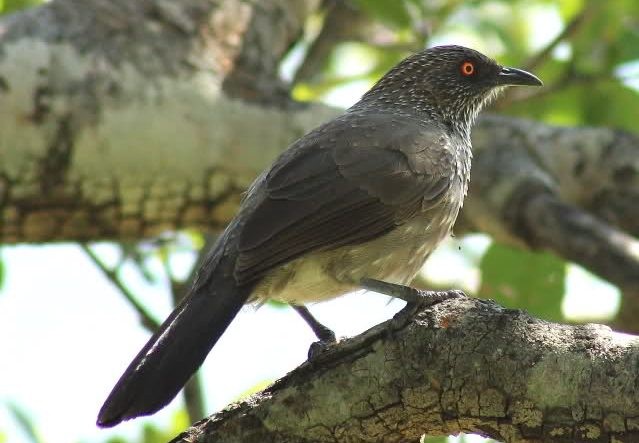 © Flutterby
© Flutterby
 © Toko
© Toko
Juvenile
 © ExFmem
© ExFmem
Immature, Kruger National Park
Links:
Species text in The Atlas of Southern African Birds
Sabap2: http://sabap2.adu.org.za/spp_summary.ph ... §ion=3
 © Flutterby
© Flutterby © Toko
© TokoJuvenile
Immature, Kruger National Park
Links:
Species text in The Atlas of Southern African Birds
Sabap2: http://sabap2.adu.org.za/spp_summary.ph ... §ion=3
Hartlaub's Babbler
562. Hartlaub's Babbler Turdoides hartlaubii (Witkruiskatlagter)
Order: Passeriformes. Family: Leiothrichidae
Description
Length 26 cm, weight 80 g.
Sexes are alike. White rump and belly are diagnostics. Reddish eyes and scalloped plumage separate it from Arrow-marked Babbler (which has streaked plumage and orange eyes). Juvenile is similar to adult but paler on the throat.
Distribution
Occurs from south-eastern DRC through Zambia and Angola to southern Africa, northern Botswana and northern Namibia (including the Caprivi Strip).
Habitat
Common in dense, tall woodland along watercourses, reedbeds and Papyrus (Cyperus papyrus) swamps.
Diet
Its diet is unknown, however it has been observed foraging on the ground in dense vegetation, often along with Arrow-marked babblers.
Breeding
It is a cooperative breeder, living in year-round groups of 5-20, usually 8 birds. The nest is a rather messy bowl built of dry leaves, grass, string and thin roots, lined with finer plant material such as slender twigs. It typically places the nest close to water, such as in a clump of reeds, flood debris attached to a tree or bush, or in a small tree in a swamp or flood plain. It has been recorded as host of the Levaillant's cuckoo.
Call
Sustained nasal pa, pa, pa, pa similar to Black-faced Babbler.
Status
Locally common resident, ususally occurring in small groups of about 5-8 birds during breeding season, and 5-15 in non-breeding season. IUCN status - not threated.
Order: Passeriformes. Family: Leiothrichidae
Description
Length 26 cm, weight 80 g.
Sexes are alike. White rump and belly are diagnostics. Reddish eyes and scalloped plumage separate it from Arrow-marked Babbler (which has streaked plumage and orange eyes). Juvenile is similar to adult but paler on the throat.
Distribution
Occurs from south-eastern DRC through Zambia and Angola to southern Africa, northern Botswana and northern Namibia (including the Caprivi Strip).
Habitat
Common in dense, tall woodland along watercourses, reedbeds and Papyrus (Cyperus papyrus) swamps.
Diet
Its diet is unknown, however it has been observed foraging on the ground in dense vegetation, often along with Arrow-marked babblers.
Breeding
It is a cooperative breeder, living in year-round groups of 5-20, usually 8 birds. The nest is a rather messy bowl built of dry leaves, grass, string and thin roots, lined with finer plant material such as slender twigs. It typically places the nest close to water, such as in a clump of reeds, flood debris attached to a tree or bush, or in a small tree in a swamp or flood plain. It has been recorded as host of the Levaillant's cuckoo.
Call
Sustained nasal pa, pa, pa, pa similar to Black-faced Babbler.
Status
Locally common resident, ususally occurring in small groups of about 5-8 birds during breeding season, and 5-15 in non-breeding season. IUCN status - not threated.
Hartlaub's Babbler Photos
562. Hartlaub's Babbler Turdoides hartlaubii
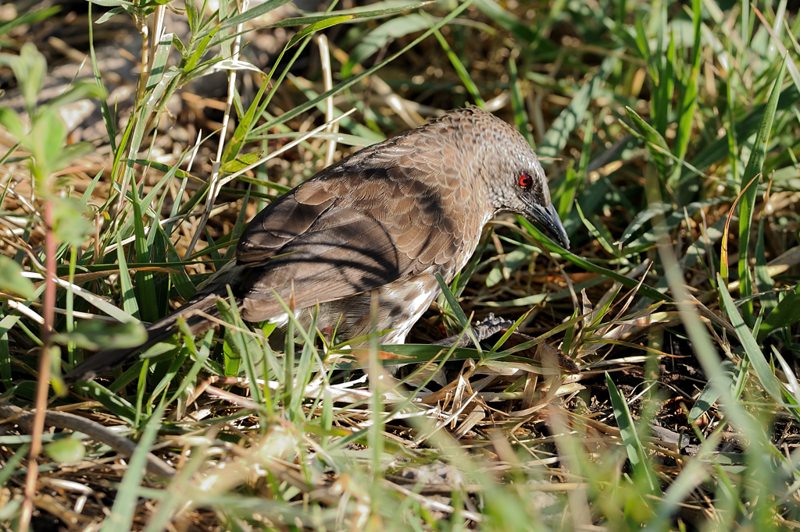 © Dewi
© Dewi
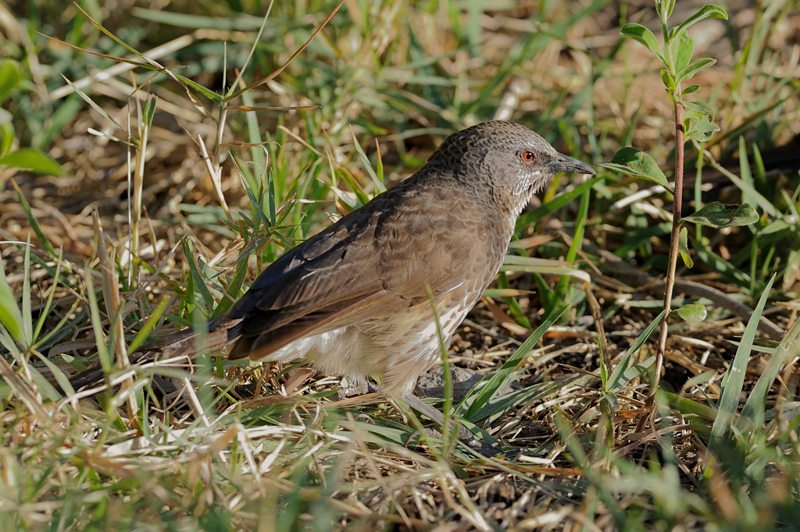 © Dewi
© Dewi
Moremi, Botswana
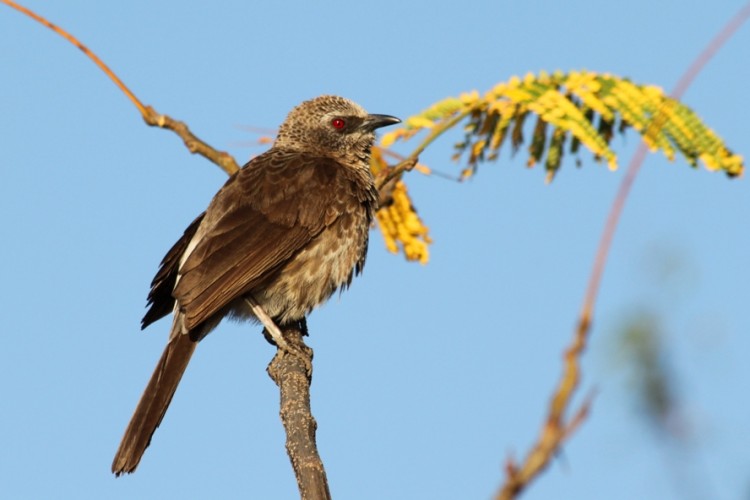 © Dindingwe
© Dindingwe
Caprivi Strip, Namibia
Links:
http://www.biodiversityexplorer.org/bir ... laubii.htm
 © Dewi
© Dewi © Dewi
© DewiMoremi, Botswana
 © Dindingwe
© DindingweCaprivi Strip, Namibia
Links:
http://www.biodiversityexplorer.org/bir ... laubii.htm
Southern Pied Babbler
563. Southern Pied Babbler Turdoides bicolor (Witkatlagter)
Order: Passeriformes. Family: Leiothrichidae
Description
Length 26 cm, weight 72-84 g.
White plumage with brownish-black wings and black tail. Black bill and feet. Reddish-orange to orange-yellow eyes.
Sexes are alike.
Juveniles have pale brown underparts and dark brown upperparts. White plumage develops on underparts first, adult plumage attained at 4-6 months.
Distribution: Endemic to southern Africa, where it is locally common in arid and semi-arid savanna woodland across northern Namibia, Botswana, Zimbabwe and northern South Africa.

Habitat
Dry savanna, often with abundance of corkwood.
Diet
It eats a variety of insects supplemented with small reptiles and amphibians, foraging in groups on the ground, flicking away leaves and twigs in search of prey. One group member perches higher up then the rest of the group, acting as a lookout for predators. Sentry duty is switched regularly, so that everyone in the group gets to forage.
Breeding
Cooperative breeder, living in year-round groups of 3 to 15 birds, all of whom help to build and defend the nest and feed the chicks.
The nest is built in about 26 days by all group members, consisting of a large bowl built of creeper and grass stems and thin twigs, lined with finer material such as rootlets and hair. It is typically placed in a fork in the center of a thorny tree, such as a Blue thorn (Acacia erubescens), Black thorn (A. mellifera), Scented thorn (A. nilotica), Umbrella thorn (A. tortilis) and Buffalo-thorn (Ziziphus mucronata). Egg-laying season is from August-April, peaking from about September-November. Eggs are pale blue with fine nodules on shell surface. The female lays 2 to 5 eggs, which are incubated for roughly 16 days. The chicks are fed by all group members, leaving the nest after about 16 days, after which they remain dependent on the group for about 10 more weeks.
Parasitised by Levaillant's Cuckoo.
Call
Various harsh chattering notes: cha, cha, cha, keeyi,keeyi, keey and kawa, kawa, kawa. Listen to Bird Call.
Status
Locally common endemic, usually in groups of 6-10 birds.
Order: Passeriformes. Family: Leiothrichidae
Description
Length 26 cm, weight 72-84 g.
White plumage with brownish-black wings and black tail. Black bill and feet. Reddish-orange to orange-yellow eyes.
Sexes are alike.
Juveniles have pale brown underparts and dark brown upperparts. White plumage develops on underparts first, adult plumage attained at 4-6 months.
Distribution: Endemic to southern Africa, where it is locally common in arid and semi-arid savanna woodland across northern Namibia, Botswana, Zimbabwe and northern South Africa.

Habitat
Dry savanna, often with abundance of corkwood.
Diet
It eats a variety of insects supplemented with small reptiles and amphibians, foraging in groups on the ground, flicking away leaves and twigs in search of prey. One group member perches higher up then the rest of the group, acting as a lookout for predators. Sentry duty is switched regularly, so that everyone in the group gets to forage.
Breeding
Cooperative breeder, living in year-round groups of 3 to 15 birds, all of whom help to build and defend the nest and feed the chicks.
The nest is built in about 26 days by all group members, consisting of a large bowl built of creeper and grass stems and thin twigs, lined with finer material such as rootlets and hair. It is typically placed in a fork in the center of a thorny tree, such as a Blue thorn (Acacia erubescens), Black thorn (A. mellifera), Scented thorn (A. nilotica), Umbrella thorn (A. tortilis) and Buffalo-thorn (Ziziphus mucronata). Egg-laying season is from August-April, peaking from about September-November. Eggs are pale blue with fine nodules on shell surface. The female lays 2 to 5 eggs, which are incubated for roughly 16 days. The chicks are fed by all group members, leaving the nest after about 16 days, after which they remain dependent on the group for about 10 more weeks.
Parasitised by Levaillant's Cuckoo.
Call
Various harsh chattering notes: cha, cha, cha, keeyi,keeyi, keey and kawa, kawa, kawa. Listen to Bird Call.
Status
Locally common endemic, usually in groups of 6-10 birds.
Southern Pied Babbler Photos
563. Southern Pied Babbler Turdoides bicolor
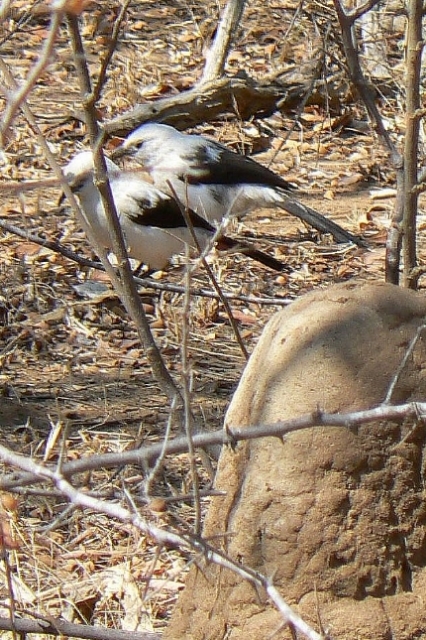 © Toko
© Toko
Marakele National Park, Limpopo
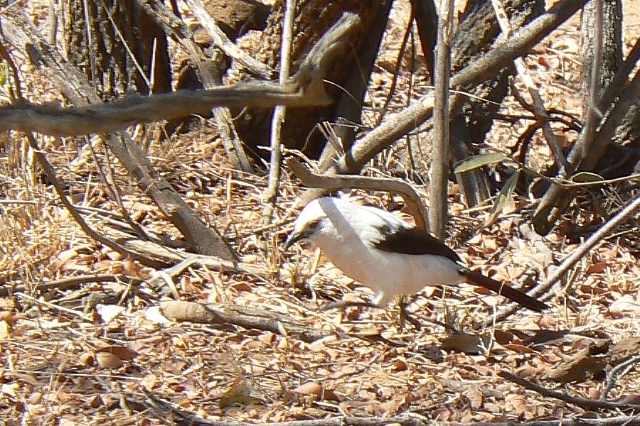 © Toko
© Toko
Marakele National Park
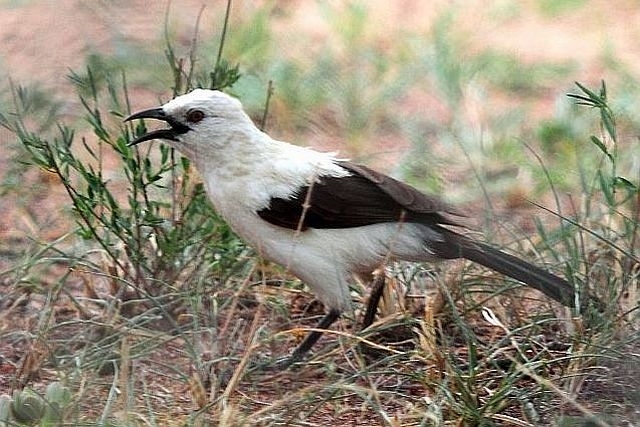 © Duke
© Duke
Borakalalo, North West Province
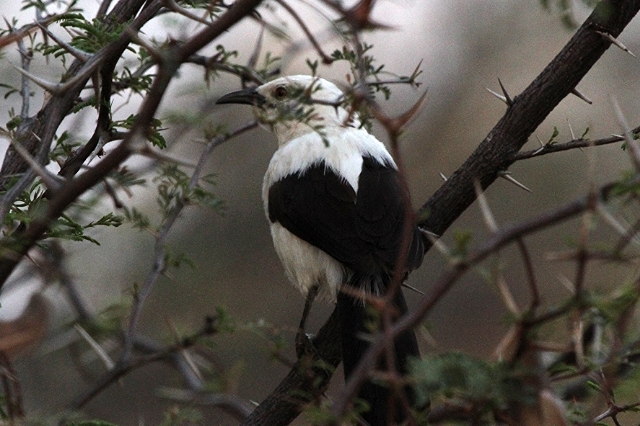 © Tina
© Tina
Kgalagadi Transfrontier Park, Nossob
Links:
Sabap2
Species Text Sabap1
Ridley, M. & Radford, A. 2006. Going gangbusters: group dynamics in Pied Babblers. Africa - Birds & Birding 11(3):50-57.
Ian Sinclar. SASOL VOELS VAN SUIDER AFRICA (3de UIT)
 © Toko
© TokoMarakele National Park, Limpopo
 © Toko
© TokoMarakele National Park
 © Duke
© DukeBorakalalo, North West Province
 © Tina
© TinaKgalagadi Transfrontier Park, Nossob
Links:
Sabap2
Species Text Sabap1
Ridley, M. & Radford, A. 2006. Going gangbusters: group dynamics in Pied Babblers. Africa - Birds & Birding 11(3):50-57.
Ian Sinclar. SASOL VOELS VAN SUIDER AFRICA (3de UIT)
Bare-cheeked Babbler
564. Bare-cheeked Babbler Turdoides gymnogenys (Kaalwangkatlagter)
Order: Passeriformes. Family: Leiothrichidae
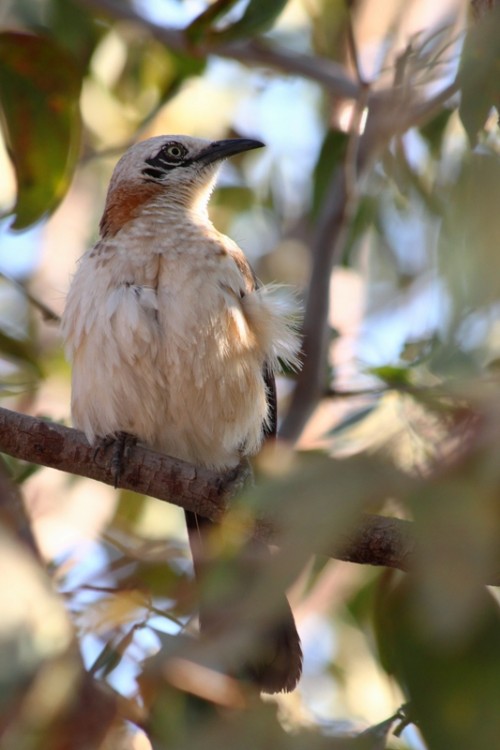 © Dindingwe
© Dindingwe
Twyfelfontein, Namibia
Description
24cm; 80g
Sexes alike. Could be confused with Southern Pied Babbler from the front but the rufous nape and brown back and tail are distinctive. Yellow eyes with bare black skin below and behind the eyes. Juveniles lack the rufous patch on the side of the neck, and are darker on the back and nape than juvenile Southern Pied Babbler.
Distribution
Near endemic to northern Namibia, as its distribution marginally extends into south-western Angola.
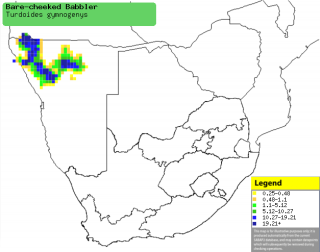
Habitat
Generally prefers undergrowth along dry rivers and streams, as well as open woodland with thickets on boulder-strewn hillsides and plains.
Diet
Eats mainly arthropods such as beetles, mantids and caterpillars, foraging in groups on the ground in the undergrowth. The groups loud calling while foraging often attracts other bird species, so the group becomes the center of a mixed species foraging flock.
Breeding
Cooperative breeder, living in noisy groups of 2-11, usually 4-6 birds. The nest is a large, loosely built bowl made of herb stems and dry grass, lined with finer plant material. It is typically placed in a multiple fork in the center of a Terminalia or Tamboti (Spirostachys africana) tree. It lays 2-3 eggs, which hatch into chicks that are cared for by all group members.
Status
Generally uncommon resident; locally common in a few localities. IUCN status- not threatened.
Order: Passeriformes. Family: Leiothrichidae
 © Dindingwe
© DindingweTwyfelfontein, Namibia
Description
24cm; 80g
Sexes alike. Could be confused with Southern Pied Babbler from the front but the rufous nape and brown back and tail are distinctive. Yellow eyes with bare black skin below and behind the eyes. Juveniles lack the rufous patch on the side of the neck, and are darker on the back and nape than juvenile Southern Pied Babbler.
Distribution
Near endemic to northern Namibia, as its distribution marginally extends into south-western Angola.

Habitat
Generally prefers undergrowth along dry rivers and streams, as well as open woodland with thickets on boulder-strewn hillsides and plains.
Diet
Eats mainly arthropods such as beetles, mantids and caterpillars, foraging in groups on the ground in the undergrowth. The groups loud calling while foraging often attracts other bird species, so the group becomes the center of a mixed species foraging flock.
Breeding
Cooperative breeder, living in noisy groups of 2-11, usually 4-6 birds. The nest is a large, loosely built bowl made of herb stems and dry grass, lined with finer plant material. It is typically placed in a multiple fork in the center of a Terminalia or Tamboti (Spirostachys africana) tree. It lays 2-3 eggs, which hatch into chicks that are cared for by all group members.
Status
Generally uncommon resident; locally common in a few localities. IUCN status- not threatened.
Last edited by Dindingwe on Thu Feb 15, 2018 2:35 pm, edited 1 time in total.
Bare-cheeked Babbler Photos
564. Bare-cheeked Babbler Turdoides gymnogenys (Kaalwangkatlagter)
 © Dindingwe
© Dindingwe
Twyfelfontein, Namibia
Links:
http://www.biodiversityexplorer.org/bir ... ogenys.htm
Roberts Bird Guide
 © Dindingwe
© DindingweTwyfelfontein, Namibia
Links:
http://www.biodiversityexplorer.org/bir ... ogenys.htm
Roberts Bird Guide


